Latchaw Creek is a 2.99 mi (4.81 km) long first-order tributary to Tunungwant Creek.[2] This is the only stream of this name in the United States.[1]
| Latchaw Creek Tributary to Tunungwant Creek | |
|---|---|
| Location | |
| Country | United States |
| State | New York Pennsylvania |
| Counties | McKean (PA) Cattaraugus(NY) |
| Physical characteristics | |
| Source | Limestone Brook divide |
| • location | about 2 miles southwest of Limestone, New York |
| • coordinates | 42°00′33.12″N 078°39′15.23″W / 42.0092000°N 78.6542306°W[1] |
| • elevation | 2,140 ft (650 m)[1] |
| Mouth | Tunungwant Creek |
• location | about 1 mile north-northwest of Foster Brook, Pennsylvania |
• coordinates | 41°59′34.23″N 078°37′30.10″W / 41.9928417°N 78.6250278°W[1] |
• elevation | 1,401 ft (427 m)[1] |
| Length | 2.99 mi (4.81 km)[2] |
| Basin size | 1.69 square miles (4.4 km2)[3] |
| Discharge | |
| • location | Tunungwant Creek |
| • average | 3.25 cu ft/s (0.092 m3/s) at mouth with Tunungwant Creek[3] |
| Basin features | |
| Progression | Tunungwant Creek → Allegheny River → Ohio River → Mississippi River → Gulf of Mexico |
| River system | Allegheny River |
| Tributaries | |
| • left | unnamed tributaries |
| • right | unnamed tributaries |
| Bridges | Camp Road, unnamed road (x3), Latchaw Hollow Road, Seaward Avenue |
Variant names edit
According to the Geographic Names Information System, it has also been known historically as:[1]
- Latchaw Run
Course edit
Latchaw Creek rises about 2 miles (3.2 km) southwest of Limestone, New York in Cattaraugus County and then flows generally southeast into McKean County, Pennsylvania to meet Tunungwant Creek about 1-mile north-northwest of Foster Brook, Pennsylvania.
Watershed edit
Latchaw Creek drains 1.69 square miles (4.4 km2) of area, receives about 44.18 in/year (112.2 cm/year) of precipitation, and is about 94.03% forested.[3]
See also edit
References edit
- ^ a b c d e f "Geographic Names Information System". edits.nationalmap.gov. US Geological Survey. Retrieved January 17, 2023.
- ^ a b "ArcGIS Web Application". epa.maps.arcgis.com. US EPA. Retrieved January 17, 2023.
- ^ a b c "Watershed Report | Office of Water | US EPA". watersgeo.epa.gov. US EPA. Retrieved January 17, 2023.

